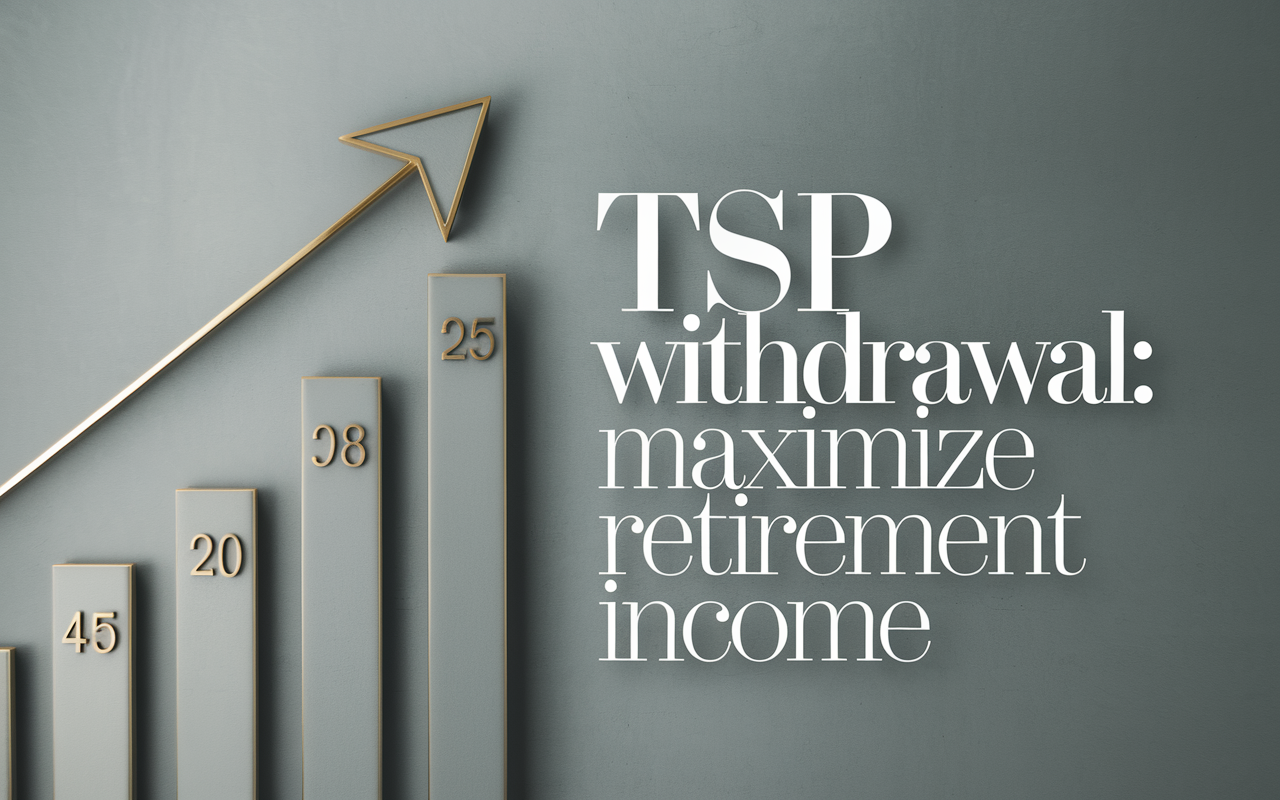TSP Withdrawal Calculator: Maximize Your Retirement Income
For federal employees, uniformed service members, and military personnel, retirement planning is more than a simple matter of saving. There is a unique blend of pension options, government matching, tax considerations, and the Thrift Savings Plan (TSP) that together shape your retirement. In this post, we will explore how you can use a TSP withdrawal calculator to help chart a course toward long-term financial security. If you are already over the age of 55, planning for or nearing retirement, and have spent your career in federal service, this overview is tailored to you.
Even if you have carefully contributed to TSP throughout your working years, there may still be questions lingering in your mind: when should I start my withdrawals? How can I coordinate these withdrawals with my FERS pension or other retirement income? Are there tax strategies that will help preserve more of my hard-earned savings? By understanding how a TSP withdrawal calculator works and using it as part of a broader strategy, you can approach retirement with greater clarity and confidence.
You can access the Thrift Savings Plan Calculator.
Why Focus on TSP Withdrawal Planning?
The Thrift Savings Plan is one of the cornerstones of retirement security for government employees. It provides multiple funds, from the relatively conservative G Fund to the more growth-oriented C, S, and I Funds. These diverse options let participants tailor their account allocations based on risk tolerance and timeline until retirement. However, shifting from earning a paycheck to living on your TSP involves a new layer of complexity, because you must balance distributions with tax efficiency, Required Minimum Distributions (RMDs), potential longevity, and market conditions.
This is where a TSP withdrawal calculator can be invaluable. It allows you to model different “what if” scenarios by adjusting your rate of return, your monthly distribution amount, your withdrawal start date, and other factors that influence how long your TSP might last. Rather than guessing how your savings might hold up through your retirement years, you can model realistic projections to help you make more informed decisions.
Key Insights Into TSP Withdrawals
There are several aspects to TSP withdrawals that federal employees should keep in mind. After you separate from federal service, you have access to your TSP balance in a variety of ways. You can:
- Take partial withdrawals for some of your balance but keep the remainder invested.
- Withdraw the entire balance at once, also known as a lump-sum withdrawal.
- Opt for installment payments (monthly, quarterly, or annual).
- Choose a TSP annuity to provide a regular, structured payment for life.
Alternatively, you might be eligible for an in-service withdrawal if you are at least 59½ years old and still working for the federal government. This option allows you to tap into your TSP funds while continuing your federal service. And whenever it is time to begin your withdrawal strategy, you should also remain aware of RMDs, which generally start at age 73 (or later if you are still employed). Missing an RMD can result in costly penalties, making it essential to plan how and when to begin taking these distributions. Learn more about TSP RMD pitfalls.
TSP Withdrawal Eligibility and Rules
Your specific eligibility depends in part on your age and your employment status. Many federal employees wonder about exactly when they are allowed to start withdrawing from TSP, especially if they need extra income before normal retirement age. Generally, you can withdraw funds after separating from federal service, but the precise age restrictions for in-service withdrawals and early withdrawals under 59½ may come with additional costs, and you should know that a 10% penalty could apply in some cases.
Here are a few key highlights to remember:
- You can access TSP in-service withdrawals if you are age 59½ or older and still working.
- After leaving federal service, you may take partial or full withdrawals, or create a schedule of installment payments.
- Required Minimum Distributions typically begin at age 73, or after you separate if that comes later.
- If applicable, failing to meet RMD requirements could mean incurring a penalty, which underscores why your distribution plan needs to be precise.
TSP Withdrawal Options: Finding the Right Mix
Because everyone’s situation is unique, there is no universal best withdrawal type. For some, a lump sum might make sense if major expenses need to be covered upfront, though that option can also create tax inefficiencies. Others prefer partial withdrawals or periodic distributions for an income stream that is predictable and may allow the remainder of their TSP balance to continue growing.
You also have the option of using the TSP annuity, potentially in combination with other distribution methods. In this scenario, you might receive a structured monthly amount via the annuity while still having part of your TSP balance for flexible withdrawals. Deciding how best to blend these approaches can be simplified if you can project how long your money will last under different scenarios—another area where the TSP withdrawal calculator can help.
How a TSP Withdrawal Calculator Works
If you have never used a TSP withdrawal calculator, imagine a tool where you can input your current account balance, your expected annual return, your desired monthly withdrawal, and basic assumptions about longevity and inflation. The calculator then generates estimates of how your funds may grow or shrink year after year, considering the returns on your chosen TSP funds and the distributions you are taking.
An effective TSP retirement calculator might ask for other relevant details, such as:
- Your contribution rate through the time you remain employed.
- Additional employer matching contributions (for FERS employees).
- Tax considerations if you have both Traditional and Roth TSP balances.
- Potential changes to your withdrawal plan, such as increasing monthly distributions overtime to account for cost of living adjustments.
- Other potential retirement income sources you expect to rely on in addition to TSP, like your FERS pension or Social Security.
By playing with various inputs, you can see how changing just one factor—like retiring a year later, or deciding to withdraw $2,000 per month instead of $2,500—might impact your plan.
Important Factors Influencing Withdrawal Projections
Many dynamics determine how long your TSP savings can sustain you. One of the major ones is your rate of return. For instance, the C Fund (which tracks the S&P 500) has had a strong long-term historical average return of around 10–11%. While those returns are impressive, short-term market fluctuations can change outcomes dramatically.
Inflation also plays a big role. A withdrawal that feels sufficient today could lose purchasing power over time if inflation runs between 2.5% and 3% annually. This is particularly critical if you anticipate a retirement horizon that could extend well into your 80s or 90s.
You may also want to model different life expectancy assumptions. Because no one can predict precisely how long they will live, planning for longevity is a prudent strategy, especially when you have the advantage of a FERS pension and Social Security that can supplement your withdrawals.
Strategies to Maximize Retirement Income
A TSP withdrawal calculator on its own is just a tool—it becomes powerful when paired with sound financial planning. Here are a few strategies that can help maximize your retirement income:
Diversify Your TSP Funds: Combining different TSP funds helps you manage risk. The G Fund offers stability, while the C, S, and I Funds can contribute to long-term growth. Balancing these elements can support a more consistent retirement outcome even in the face of market volatility.
Decide Between Roth and Traditional TSP Withdrawals Wisely: Taxes matter greatly. Traditional TSP withdrawals are taxed as ordinary income, whereas qualified Roth distributions are tax-free. In many cases, a blend of the two can create the best tax outcome, so consider the impact carefully before finalizing your withdrawal mix.
Think About Timing: Retirement timing can be crucial. Waiting a few extra months or years before you take larger withdrawals acts a bit like supercharging your account, allowing your investable TSP balance to remain in the market longer.
Coordinate With Social Security: For some federal employees, it may make sense to postpone Social Security benefits to receive a higher monthly payout later, while using TSP funds in the interim. The best decision differs based on your personal finances, health, and retirement goals. Learn more about Social Security for federal employees.
Avoid RMD Pitfalls: Once RMDs become mandatory, you must withdraw a certain portion of your TSP each year. Good planning ensures that these required withdrawals work in harmony with your other retirement distributions and do not cause unintended tax consequences.
Case Study: Susan’s Retirement Journey
To illustrate how calculators and strategy intersect, consider a hypothetical scenario: Susan is a federal employee planning to retire at age 65. She is 46 now, earning a salary of $55,000, and currently has $53,000 in her TSP. She contributes 5% of her salary to TSP (enough to capture the full government matching contribution), and she aims to replace roughly 80% of her final salary with her FERS pension, Social Security, and TSP.
Upon retiring, Susan wants to maintain a lifestyle comparable to her working years, which means she may need withdrawal amounts of around $2,700 monthly from TSP if her pension and Social Security cover the rest. To get a sense of how her TSP might grow and whether that $2,700 monthly distribution is realistic, she uses a TSP withdrawal calculator with different rates of return, factoring in a 2.5% inflation rate.
Susan’s Projected TSP Balances
Below is an example of how her TSP balance might look under different average annual return assumptions by the time she is ready to retire at 65:
| Return Assumption | Projected Balance at Retirement | Estimated Funds Survival (Years) |
|---|---|---|
| 5% Average Annual Return | $351,695 | Until ~Age 80 |
| 7% Average Annual Return | $456,361 | 30+ Years |
From these high-level calculations, Susan sees that the difference between a 5% return environment and a 7% return environment can be significant for her retirement security. While no one knows precisely what the markets will provide, adjusting year-by-year assumptions can help her remain flexible.
Withdrawal Illustrations
Another way for Susan to use the TSP withdrawal calculator is modelling various monthly distributions at different inflation assumptions, so she can see how quickly her funds might be depleted. The following table shows an illustration of how these factors interplay:
| Monthly Withdrawal | Annual Inflation Adjustment | Years Until Depletion |
|---|---|---|
| $2,000 | 2.5% | 25 |
| $2,500 | 3.0% | 20 |
In this simplified illustration, taking $2,500 a month with a higher annual inflation rate means balancing the need for slightly more income now with a faster drawdown of the TSP. By consulting a professional and periodically updating her assumptions in a withdrawal calculator, Susan can refine her strategy.
Data Visualization Takes the Guesswork Out
Sometimes, seeing the numbers laid out in a table or chart can be far more impactful than reading them in a paragraph. That’s the edge a TSP withdrawal calculator can provide. By visualizing your potential account balance over time, you can see how sensitive your plan is to changes in risk level or withdrawal size. This insight can empower you to consider a more conservative or more aggressive approach, depending on your retirement goals and personal comfort with market fluctuations.
Putting It All Together
The real value in using a TSP withdrawal calculator lies in approaching it as part of a comprehensive strategy. By combining your TSP distribution strategies with FERS pension benefits and, ultimately, Social Security, you can shape a retirement income plan that reflects your lifestyle needs. Selecting the right TSP withdrawal rules—whether that is partial withdrawals, full withdrawals, or monthly installments—can make a tangible difference in how you experience retirement. Being conscious of TSP withdrawal options and their tax implications helps you keep more of your assets working for you.
Because your situation is unique, it is often wise to consult credentialed professionals who fully understand federal retirement benefits. At PlanWell, our advisors hold designations like ChFEBC, CFP, and AIF. If you are looking for a financial advisor for federal employees, we can provide the specialized guidance you need. They can help you sort through the technical details around how your TSP interacts with your pension and Social Security, the best ways to mitigate taxes on your withdrawals, and how to manage the risk of outliving your savings.
Learn more about Federal Retirement Planning
Plan for Tomorrow—Starting Today
For federal employees, the TSP is not just another retirement account; it is typically a pillar of retirement income. At age 55 or beyond, thinking about how a TSP withdrawal calculator might safeguard your future can be one of the most empowering steps you can take. If you have not tested out different distribution strategies and returns assumptions yet, now is the time.
Ultimately, the better prepared you are, the more control you will have when unexpected events or market surprises enter the picture. With careful analysis, you can work to maximize your federal benefits and reduce the chance that you will face unwelcome financial surprises in retirement.
Take the Next Step
If you would like to delve deeper into how to effectively use a TSP withdrawal calculator or would like personalized guidance specific to your situation, consider taking part in one of our free Federal Retirement Planning Workshops. These sessions will walk you step by step through key considerations like RMDs, partial withdrawals, and how to integrate TSP income into a retirement strategy that also includes your FERS pension and Social Security.
Sign up for one of our free Federal Retirement Planning Workshops and take a confident step toward maximizing the retirement income you have worked so hard to build.










